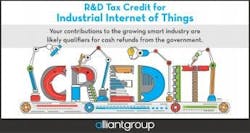Congress has, in recent years, made great efforts to enrich smart industries. Smart industries, in turn, have greatly failed to take full advantage.
There is a massive tax incentive in place that rewards practical innovation among tech businesses, and the initiatives that fall under that generic term are wide—product-development, version 2.0, beta mode, trial-and-error, etc.
Anything sound familiar?
Depending on the nature of your business, you might consider some of the government’s qualifying research-and-development activities as mere technical curiosity, behavior that is woven into your daily businesses practices. You might be pleasantly surprised to learn that your business is eligible for the government’s Research and Development Tax Credit.
First, abandon the notion that R&D is limited to clinical trials, patentability and mad scientists. The R&D Tax Credit now applies to a range of explorative industries—controls and automation sciences, engineering and software-development, contract-manufacturing and systems-integration.
And as someone who has spent his career guiding businesses through tax code, I know this credit is as lucrative as it is misunderstood, especially for small and mid-sized businesses. The IRS estimates that $10.8 billion in federal R&D credits were claimed in 2012 (the most recent tax year on record), and in that year, 89% of that payout was awarded to larger companies with annual revenues exceeding $50 million. Small and mid-sized businesses are largely unaware that they are just as eligible as larger corporations. Because of a lack of public disclosure about the opportunity, many small-business owners assume that they are ineligible or that the hassle will outweigh the payoff.
Smart PATH for innovation
In a nutshell, the government wants to reward enterprises that try new things. The PATH Act, enacted in late 2015, has widened eligibility to masses of companies that had been subject to the alternative minimum tax (AMT) bar, which effectively precluded them from qualifying for the R&D Tax Credit.
The newly widened pool of participants is what was always intended for the R&D Tax Credit. Congress is prepared to provide more businesses that are making technical contributions to the American economy with the resources to think bigger, produce better and succeed more.
The U.S. government is refunding massive sums—millions for some—to businesses that can prove that they’re leveraging technology to stay competitive. Why is Uncle Sam doing this? The rationale is that these savings will be reinvested in buying new equipment, hiring new employees, expanding service offerings, etc.
These reinvestments help businesses qualify for the credit in subsequent years, not to mention boosting employment rates, and contributing to the country’s economic growth and global positioning in technology markets.
Win. Win. Win.
IIoT R&D
Businesses that make use of sophisticated, multi-disciplinary technologies have a great shot at qualifying for the R&D Tax Credit. In fact, what makes “smart” businesses so well-positioned to claim savings is that many do three things that qualify for the credit: 1) utilize manufacturing, 2) utilize software and 3) utilize engineering services to accelerate technological advancements.
Anything sound familiar?
Taking advantage of the tax credit is a smart move for companies that:
- Resolve unique automation challenges for diverse applications
- Deliver custom solutions that utilize design engineering and data-driven technologies
- Develop software or schematic drawings
- Perform evaluations, feasibility studies and system tests to ensure optimal functionality
- Program automated controllers such as industrial PCs, PLCs and HMIs
- Overcome regulatory compliance challenges
- Implement cost-effective or innovative operational processes
- Install, assimilate, maintain and/or fabricate machinery
Anything sound familiar?
Michael Siegel, managing director at alliantgroup, provides tax, accounting and consulting services for U.S. companies. Contact Michael at [email protected]






